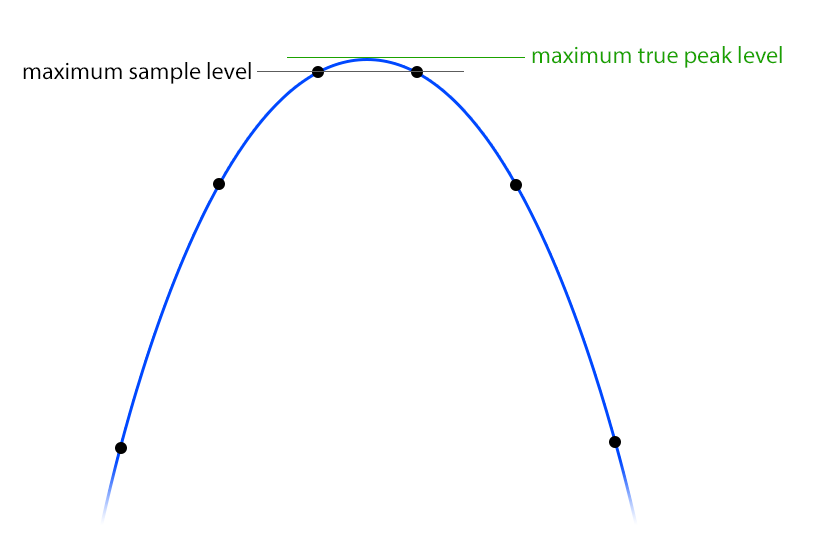FabFilter Pro-L 2 online help
Table of contents
Go to sectionFabFilter Pro-L 2 Help
Introduction
Using FabFilter Pro-L 2
Full Screen mode, resizing and scaling
Presets
Purchasing FabFilter Pro-L 2
Support
True peak limiting
Digital audio processing, and especially ultra-fast limiting or hard clipping in the digital domain, can introduce inter-sample peaks. In this case, the analog signal that a D/A converter would generate from the sample values becomes higher than the individual sample values. Depending on how good the D/A converter is, this can cause audible clipping. The same happens during operations like MP3 conversion.

As illustrated by this image, the analog signal (blue) has a peak (green) that is higher than the sample peaks in the digital signal. Peaks like these are called inter-sample peaks or true peaks. Today, many commonly used metering/loudness standards, like EBU R128 or ATSC A/85 impose a maximum allowed true peak level.
To guarantee that FabFilter Pro-L 2's output doesn't exceed a certain maximum true peak level, enable the True Peak Limiting option in the bottom bar.

True Peak Limiting works at two different stages:
- The limiting process will detect true peaks that already exist in the input signal, and reduce them appropriately.
- Any true peak overshoot introduced by the ultra-fast limiting process itself, will be smoothly attenuated afterwards, ensuring the final true peak output doesn't exceed the current maximum true peak Output Level.
When using True Peak Limiting, it's best to keep True Peak Metering enabled as well, using the TP button next to the display and meter scale settings. The output level meter will then show the actual true peak levels (with level reading in green to reflect this). See Metering.
Of course, FabFilter Pro-L 2's true peak metering system fully complies with the ITU-R BS.1770 and EBU R128 standards, and is suitable for MFiT (Mastered for iTunes).
Preventing true peak overshoot
Instead of letting the true peak limiting process deal with remaining true peaks in the output, it's even better to prevent high true peak overshoot in the first place. The best way to minimize inter-sample peaks and distortion, is to use oversampling. In addition, increasing the lookahead can also help quite a lot, but may affect loudness and transparency.
In most cases, choosing 4x oversampling in combination with a minimum lookahead time of 0.1 ms, keeps inter-sample peaks within a range of 0.1 dB.
Tips
- When True Peak Limiting is enabled, the Output Level read-out and parameter value display will show its value as "dBTP" (dB True Peak) instead of "dB" (dBFS or dB Full Scale).
- The additional processing needed for true peak limiting will introduce a bit of extra latency (about 5 ms). If you need to minimize latency, you can disable true peak limiting and oversampling and choose one of the limiting styles from Pro-L version 1 (e.g. Transparent).
Next: Metering
See Also
Overview
Recommended workflow
